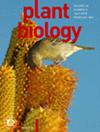Alkaloids and antioxidant mechanisms in galls: insights from Peumus boldus–Dasineura sp. interactions
IF 3.6
3区 生物学
Q1 PLANT SCIENCES
引用次数: 0
Abstract

生物碱和抗氧化机制在胆囊:从Peumus boldus-Dasineura sp.相互作用的见解。
一种原产于智利的树,其生物碱以其抗氧化特性而闻名。鉴于这棵树的茎中有Dasineura sp. (cecidomiidae)诱导出瘿,而这种相互作用中的生物碱动力学在很大程度上尚未被探索,我们假设茎中的生物碱有助于维持瘿内的氧化还原平衡。然而,生物碱的组成和积累可能被胆囊诱导昆虫改变,最终降低宿主器官的体外抗氧化活性。采用Dragendorff试剂进行定性检测,采用气相色谱-质谱联用技术进行定量分析,分析了青松茎在生长发育(GDG)、成熟(MG)和衰老(SG)三个阶段生物碱的变化。通过DPPH和ABTS测定抗氧化活性。非连接茎(NGS)作为对照。组织化学分析显示生物碱的重新分布,最初集中在营养组织和周围组织,然后在后期转移到周围的胆囊组织。检测到的生物碱主要为异喹啉衍生物,主要为阿啡类,其组成和相对丰度随器官和胆期的不同而不同。NGS中有11种生物碱,GDG中有13种,MG中有11种,SG中有15种。所有样本中只有三种生物碱。不同提取物的抗氧化活性差异显著:NGS活性最高,MG最低,SG中间值-与ABTS试验中的对照组相当。黄颡鱼茎中的生物碱参与维持胆内氧化还原平衡,但其在胆发育阶段的积累和组成变化导致抗氧化活性下降。
本文章由计算机程序翻译,如有差异,请以英文原文为准。
求助全文
约1分钟内获得全文
求助全文
来源期刊

Plant Biology
生物-植物科学
CiteScore
8.20
自引率
2.60%
发文量
109
审稿时长
3 months
期刊介绍:
Plant Biology is an international journal of broad scope bringing together the different subdisciplines, such as physiology, molecular biology, cell biology, development, genetics, systematics, ecology, evolution, ecophysiology, plant-microbe interactions, and mycology.
Plant Biology publishes original problem-oriented full-length research papers, short research papers, and review articles. Discussion of hot topics and provocative opinion articles are published under the heading Acute Views. From a multidisciplinary perspective, Plant Biology will provide a platform for publication, information and debate, encompassing all areas which fall within the scope of plant science.
 求助内容:
求助内容: 应助结果提醒方式:
应助结果提醒方式:


